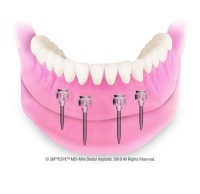Let Your General Dentist in Canton OH Care for Your Smile during Your Routine Visit
Dental Cleanings
Routine dental cleanings are important to maintaining good oral hygiene. Professional cleaning by a hygienist can remove mineralized plaque that may develop even with careful brushing and flossing, particularly in areas that are difficult to reach. It is recommended you go in for a cleaning once every six months.
How it's done
You can expect your dental cleaning to last between 30 minutes and an hour. Typically, a trained hygienist will do the cleaning, and a dentist may come in for an exam at the end. Most people find that dental cleanings are painless, and do not cause any discomfort.
There are two important steps to a dental cleaning. The first step is scaling the teeth, whereby the hygienist will remove the plaque and tartar from the tooth surfaces. This can be performed by hand or with electric scalers depending on the hygienists preference.Typically, the hygienist will also clean the pockets of the gums to remove any plaque buildup there.
The second step is polishing to remove any final plaque and buff the teeth. Polishers generally have several different sized heads to clean hard to reach places.
Dental Exams and X-Rays
Routine dental exams are important to maintaining healthy teeth and gums. Additionally, they can help to avoid the financial costs associated with large treatment plans later on. The Academy of General Dentistry recommends twice yearly checkups for people of all ages. At this frequency, most problems can be caught while they remain in an early stage.
How it's done
The dentist first examines your mouth visually, using dental equipment such as mouth mirrors, assorted dental tools, and high-intensity lights. They will look for cracked and decayed teeth, as well as review other important items such as:
- Medical history: The dentist will assess how any new medical conditions or illnesses may affect your dental health.
- Examination of tooth decay: Your mouth will be checked for cracked or decayed teeth.
- Oral cancer screening: The face, neck, lips, tongue, throat, tissues, and gums will be checked for any signs of oral cancer.
- Gum disease evaluation: Your gums and bone around the teeth will be checked for any evidence of periodontal disease.
- Examination of existing restorations: Current fillings, crowns, and other restorations are made sure to be in good order.
Additionally, your dentist will take diagnostic x-rays to reveal any other hidden problems, especially in the areas below the gums. Bitewing x-rays are typically taken every 12 months and a panographic x-ray, which revolves around the head, is taken every 3-5 years.
Composite Fillings
When treating a cavity, the dentist will remove the decayed portion of your tooth and fill it with another substance. This procedure is called a filling. There are multiple options for the material to be used in the filling, the most common of which are composite fillings and amalgam fillings.
A composite filling is also known as a tooth colored filling since the material used in the filling can be closely matched to the color of your teeth. Composite fillings provide good durability for small to medium cavities, and the procedure typically involves removing less of a tooth than you would during an amalgam filling. They are also particularly well suited for treating front or highly visible teeth because of their natural look.
When can a composite filling be used for?
- Decayed tooth (i.e. cavity)
- Chipped or broken teeth
- Decreasing the gap between teeth
How its done
After the dentist numbs the area where the filling is to be placed, he will remove any decayed portions. A substance is then applied to help open up the pores of your teeth for a stronger bond, and hardened and cured with a special light. Once this is complete, the filling is applied in thin layers to slowly form the complete filling. After the composite has hardened, the filling will be smoothened and polished to be comfortable and fit your bite.
Amalgam Fillings
Amalgam fillings, also known as silver-colored fillings, are made from a combination of metals such as tin, copper, silver and mercury. This combination of metals gives amalgam its renowned strength and durability. These fillings usually last between 10 – 15 years compared to composite fillings which typically last about 5 years. Because of its strength, these fillings are particularly useful for use on the molars in the back of the mouth, where the most chewing occurs. Its silver color is also less visible when placed on molars in the back of the mouth. As an added benefit, amalgam fillings are typically more cost effective than composite “white” fillings.
How it’s done
The procedure is done by first removing the decaying portion of the tooth. Once that is complete, the tooth is shaped in a specific way to accept the filling. The amalgam is then placed into the tooth. A band may be placed around your tooth during the process to help the amalgam condense. The filling is then adjusted and polished to fit your bite for maximum comfort.
Additional information
After you’ve had your tooth filled with amalgam, you may experience a temporary period of heightened hot and cold tooth sensitivity. Additionally, amalgam fillings do not harden instantaneously, and it’s advisable to avoid chewing in that area for a few hours. Make sure to consult your dentist to understand which type of filling is right for you.
Root Canal Therapy
Root canal therapy is treatment used to repair and save a tooth that has been infected due to a deep cavity or cracked tooth. The treatment involves removing the pulp and the nerves of the tooth and cleaning the infected area. A tooth's pulp and nerve are not important to a tooth's health and function after the tooth has fully emerged from the gums. If the treatment is not performed, bacteria builds up at the root tip and the infection of the pulp can spread to the surrounding bone. The results in pain and swelling and your tooth would likely have to be removed.
What are the signs that a root canal is needed?
- Severe tooth pain while chewing
- Your tooth pain wakes you up at night
- Teeth that are highly sensitive to hot or cold, with the sensitivity lingering for some time.
- Discoloration or darkening of the tooth
- Swollen gums in the area of the infected tooth
What does the treatment involve?
First, an opening is made into the pulp chamber through the crown of the tooth. Once the pulp is removed, the root canal is thoroughly cleaned. If the dentist decides to complete the root canal therapy in multiple visits, a temporary filling will be placed to protect the tooth. When you return, the dentist will remove the temporary filling, re-clean the root canal and pulp chamber, and place a permanent filling and / or crown over the tooth.
Root canal therapy has a high rate of success any many teeth undergoing the procedure can be saved to last a lifetime. Additionally, the crown or filling placed the completion of the procedure makes it hard to notice by others that you had the treatment.
Tooth Extractions
A dental extraction is a procedure to remove a tooth from your mouth. A dental extraction is most commonly required if one of your teeth is damaged beyond practical repair. The most common reasons for tooth extractions include:
- Severe tooth decay or infection may make it impossible or too costly to repair a tooth
- Advanced gum disease may require a tooth to be pulled so it doesn’t affect the supporting tissues and bone structures of your mouth
- A tooth may be extracted if it is blocking other teeth from coming in
- During orthodontic work, teeth may need to be extracted to create room for the teeth that are being moved into place
- Wisdom teeth are often extracted either before or after they come in
What to expect
Your dentist will first administer anesthetic to numb the area and reduce discomfort. During the extraction, you will feel the pressure of the tooth being removed, but will not feel any pain. Typically, the dentist is able to remove your tooth within a matter of minutes.
Immediately after the tooth extraction, a small amount of bleeding is normal and a patch of gauze will be placed in the affected area. The area may bleed minimally for the next 24 hours or so and taper off after that. Follow your dentist's instructions on how often to change the gauze, and what other post-procedure steps to follow.










